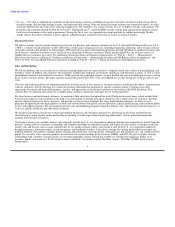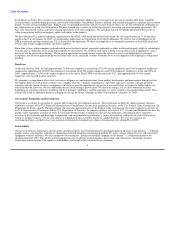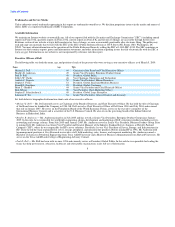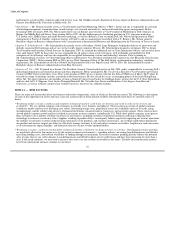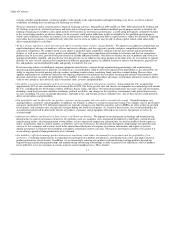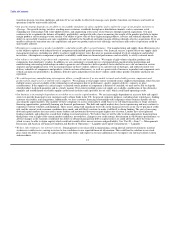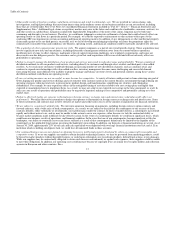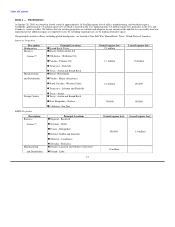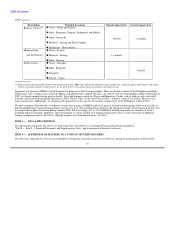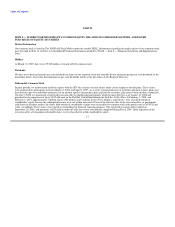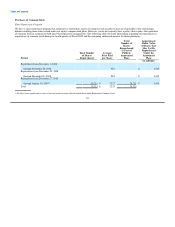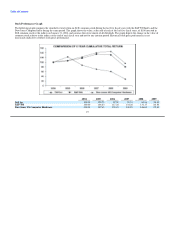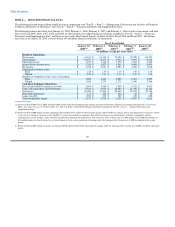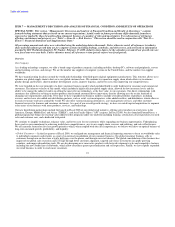Dell 2008 Annual Report Download - page 15
Download and view the complete annual report
Please find page 15 of the 2008 Dell annual report below. You can navigate through the pages in the report by either clicking on the pages listed below, or by using the keyword search tool below to find specific information within the annual report.
Table of Contents
extreme volatility and disruption, resulting in higher credit spreads in the capital markets and higher funding costs for us, as well as reduced
availability of funding from securitizing our financing receivables.
We have continued to utilize securitizations to fund our financing activities. During Fiscal 2009 and Fiscal 2008, Dell transferred $1.4 billion and
$1.2 billion, respectively, of fixed-term leases and loans and revolving loans to unconsolidated qualified special purpose entities to facilitate the
funding of financing receivables in the capital markets. Deterioration in our business performance, a credit rating downgrade, continued volatility
in the securitization markets, or adverse changes in the economy could lead to reductions in debt availability for the qualified special purpose
entities and could limit our ability to continue asset securitizations or other financing from debt or capital sources, reduce the amount of financing
receivables that we originate, or could adversely affect the costs or terms on which we may be able to obtain capital, which could unfavorably
affect our profitability or cash flows.
• We face strong competition, which may adversely affect our market share, revenue, and profitability. We operate in an industry in which there are
rapid technological advances in hardware, software and service offerings, and face aggressive product and price competition from both branded
and generic competitors. We compete based on our ability to profitably offer competitive solutions with the most current and desired product
features, as well as on customer service, quality and reliability. We expect that competition will continue to be intense and that our competitors'
products may be less costly, provide better performance or include additional features. Our efforts to balance our mix of products and services to
optimize profitability, liquidity, and growth may also put pressure on our industry unit share position in the short-term. As we continue to expand
globally, we may see new and increased competition in different geographic regions. In addition, barriers to entry in our businesses generally are
low and products can be distributed broadly and quickly at relatively low cost.
If our increasing reliance on third-party original equipment manufacturers, original design manufacturing partnerships, and manufacturing
outsourcing relationships fails to generate cost efficiencies, our profitability could be adversely impacted. Our profitability is also affected by our
ability to negotiate favorable pricing with our vendors, including vendor rebates, marketing funds, and other vendor funding. Because these
supplier negotiations are continuous and reflect the ongoing competitive environment, the variability in timing and amount of incremental vendor
discounts and rebates can affect our profitability. Our inability to establish a cost and product advantage, or determine alternative means to deliver
value to our customers, may adversely affect our market share, revenue, and profitability.
• Our ability to generate substantial non-U.S. net revenue faces many additional risks and uncertainties. Sales outside the U.S. accounted for
approximately 48% of our consolidated net revenue in Fiscal 2009. Our future growth rates and success are dependent on continued growth outside
the U.S., including the key developing countries of Brazil, Russia, India, and China. Our international operations face many risks and uncertainties,
including varied local economic and labor conditions, political instability, and changes in the regulatory environment, trade protection measures,
tax laws (including U.S. taxes on foreign operations), copyright levies, and foreign currency exchange rates. Any of these factors could adversely
affect our operations and profitability.
• Our profitability may be affected by our product, customer, and geographic sales mix and by seasonal sales trends. Our profit margins vary
among products, customers, and geographies. In addition, our business is subject to certain seasonal sales trends. For example, sales to government
customers (particularly the U.S. federal government) are typically stronger in our third fiscal quarter, sales in EMEA are often weaker in our third
fiscal quarter, and consumer sales are typically strongest during our fourth fiscal quarter. As a result of these factors, our overall profitability for
any particular period will be affected by the mix of products, customers, and geographies reflected in our sales for that period, as well as by
seasonal trends.
• Infrastructure failures and breaches in data security could harm our business. We depend on our information technology and manufacturing
infrastructure to achieve our business objectives. If a problem, such as a computer virus, intentional disruption by a third party, natural disaster,
manufacturing failure, telecommunications system failure, or lost connectivity impairs our infrastructure, we may be unable to book or process
orders, manufacture, ship in a timely manner, or otherwise carry on our business. An infrastructure disruption could damage our reputation and
cause us to lose customers and revenue, result in the unintentional disclosure of company or customer information, and require us to incur
significant expense to eliminate these problems and address related data security concerns. The harm to our business could be even greater if it
occurs during a period of disproportionately heavy demand.
• Our inability to effectively manage product and services transitions could reduce the demand for our products and the profitability of our
operations. Continuing improvements in technology mean frequent new product introductions, short product life cycles, and improvement in
product performance characteristics. In addition, we are increasingly sourcing new products and transitioning existing products through our
original design manufacturing partnerships and manufacturing outsourcing relationships in order to generate cost efficiencies, deliver products
faster and better serve our customers in certain segments and geographical areas. These product
11





